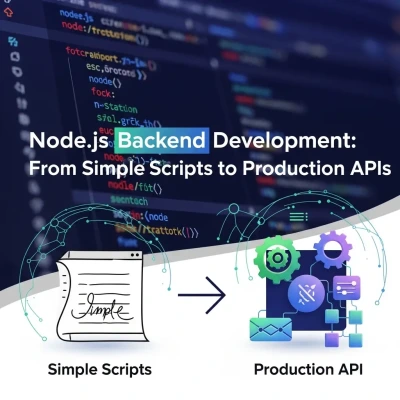Modern web development demands speed, scalability, and maintainability. Node.js, with its event-driven, non-blocking I/O model, has emerged as a go-to choice for backend development. But writing code that works isn’t enough—you need to build production-ready applications.
In this post, we’ll explore how to take your Node.js backend to the next level with clean architecture, robust tooling, and smart deployment strategies.
Table Of Contents
- 🔧 1. Start with a Solid Project Structure
- 🧱 2. Choose the Right Frameworks and Libraries
- 🛡️ 3. Implement Security Best Practices
- 🔍 4. Add Proper Logging and Monitoring
- ✅ 5. Write Tests and Use CI/CD
- 🚀 6. Prepare for Deployment
- 🧰 Bonus: Developer Experience Tips
- Final Thoughts
🔧 1. Start with a Solid Project Structure
A clear folder structure makes it easy to maintain and scale your codebase. For example:
src/
│
├── config/ # Configuration files
├── controllers/ # Route controllers
├── services/ # Business logic
├── routes/ # Express routes
├── middlewares/ # Custom middleware
├── utils/ # Helper functions
└── app.js # Main app entry
✅ Tip: Use environment variables with
dotenvto manage settings like database URIs and API keys.
🧱 2. Choose the Right Frameworks and Libraries
- Express.js – Lightweight and flexible
- Fastify – Fast and low overhead
- NestJS – Opinionated and enterprise-grade
Don’t overengineer, but don’t reinvent the wheel either. Add tools like:
- Joi or Zod for input validation
- Helmet for HTTP headers security
- Winston or Pino for logging
- Mongoose/Prisma/TypeORM for database management
🛡️ 3. Implement Security Best Practices
Production apps must be secure by default:
- Sanitize all user inputs.
- Prevent XSS and CSRF attacks.
- Use HTTPS (SSL) and secure cookies.
- Keep dependencies updated to patch vulnerabilities.
- Enable rate limiting to prevent abuse.
const helmet = require("helmet");
app.use(helmet());
🔍 4. Add Proper Logging and Monitoring
Use structured logs and track metrics:
- Pino/Winston – Log requests, errors, and events
- Sentry – Track exceptions in real time
- Prometheus + Grafana – Monitor server health
Logs should include:
- Request IDs for traceability
- Timestamps
- Error stack traces
✅ 5. Write Tests and Use CI/CD
Testing ensures reliability and confidence in deployments:
- Unit Tests with Jest or Mocha
- Integration Tests with Supertest
- Use GitHub Actions or GitLab CI for automation
npm test
🚀 6. Prepare for Deployment
Your app must run smoothly in production:
- Use PM2 or Docker to manage processes
- Set
NODE_ENV=productionfor performance - Optimize memory and garbage collection
- Use nginx as a reverse proxy
- Deploy to Heroku, AWS, or DigitalOcean
pm2 start app.js --name="my-api"
🧰 Bonus: Developer Experience Tips
- Add Swagger/OpenAPI docs for your API
- Use ESLint + Prettier for consistent code
- Set up Husky to run linting on pre-commit
- Enable hot reloading during development (e.g.,
nodemon)
Final Thoughts
Building a production-ready Node.js backend is about much more than writing working code. You need to think about security, maintainability, performance, and monitoring. By following the best practices above, you can ship reliable applications that scale with confidence.


Add Comment
No comments yet. Be the first to comment!